The pictures on this page were found in Bristol Central Reference Library, to reproduce please email refandinfo@bristol.gov.uk
The April and August ‘riots’ of 2011 in Bristol, along with those of the 1980s, have been characterised as being exceptional events in the city’s history. However, Bristol has a long history of violent disturbances from the food and price ‘riots’ of the 18th Century, through the reform uprisings of 1831 to ‘Black Friday’ in 1892. One period which has received less interest is the ‘depression’ of the early 1930s when thousands of unemployed Bristolians marched against ‘cuts’ in benefits and were faced with police baton charges and politically inspired trials of their leaders.
February 1932, eighty years ago, was a key month in the unemployed protests in Bristol which were organised by the recently formed branches of the National Unemployed Workers’ Movement (NUWM). At this point unemployment levels in the city were at their peak with 26,561 registered unemployed in Bristol (an underestimate as many were not recorded). In January 1932 the City Council, following the coalition Government’s policy, decided to reduce unemployment benefits by about 10%, increasing the burden on families already at desperate levels of poverty. Since the ‘Wall Street Crash’ of 1929 joblessness in Bristol had risen to unprecedented levels; by February 1932 the situation was critical with whole districts blighted by the effects of mass unemployment.
The response to the proposed austerity measures was a series of pickets, mass meetings and marches of thousands of unemployed Bristolians organised by the NUWM throughout 1932. The NUWM and their supporters were demanding the non-implementation of the ‘cuts’ and a programme of public works to provide employment. In February 1932 the NUWM organised two marches to the Council House on Corn Street to lobby the meetings setting the benefit levels. The previous year, in September 1931, a delegation of 150 Welsh Hunger Marchers had arrived in Bristol to lobby the TUC at the Victoria Rooms in Clifton. They and their Bristolian supporters were baton charged by the police and prevented from sending a delegation into the congress. Two days later thousands of Bristolians turned out to prevent a second baton charge on the marchers. It was a sign of things to come.
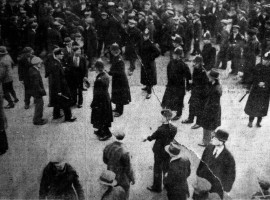
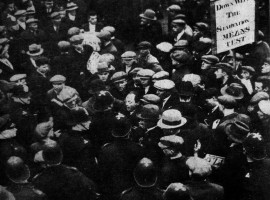
On 9th February 1932, the NUWM led 3,000 unemployed marchers down Old Market Street towards Castle Street. A police cordon at Carey’s Lane (now the inner-city ring road) attempted to divert the marchers away from the route to the Council House. After a brief altercation, the police both on foot and mounted on horses, batons drawn, charged the crowds and violently broke up the procession. The NUWM were unbowed and after an angry mass meeting the same night in the Horsefair decided to march again, two weeks later, on Tuersday 23rd February.
This time, the demonstration was even larger, with estimates of the numbers ranging from 3,000 to 15,000 protesters. The police had banned the march but the NUWM were not deterred. The peaceful procession followed a winding route but ended up once again on Old Market Street to be faced by a double row of police with batons drawn and backed up by mounted officers at the junction with Castle Street. The marchers were unaware that the Chief Constable had planned in advance to ambush the NUWM leadership by secreting a large number of police in the annex to the Empire Cinema on Carey’s Lane. The march halted at the police line but as the crush of marchers forced the front ranks forwards, the police launched an assault on the head of the procession. Almost simultaneously the hidden police charged out of the Cinema annex and split the march in two. In the confusion, the police attempted to break up the procession by beating and chasing the protestors up Old Market Street as they had done two weeks previously. This time however they were faced by determined resistance.
Demonstrators raided scrap yards and passing lorries for ammunition, grabbed handfuls of vegetables from street traders and ransacked coal wagons, hurling the contents at the pursuing police. The centre of the ‘rioting’ shifted to Lawford’s gate at the east end of Old Market Street, spread into the neighbouring areas of St. Phillip’s and St. Jude’s and continued for nearly two hours. Despite the police attempt to break up the demonstration, the NUWM called a mass meeting on Welsh Back later that evening. Thousands of Bristolians gathered near Bristol Bridge, jeering and goading the hundreds of police present and when the NUWM moved off stampeded down Bridge Street and Castle Street breaking windows and attacking motor cars.
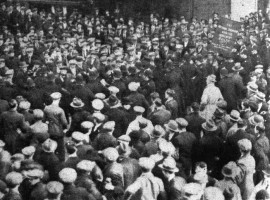
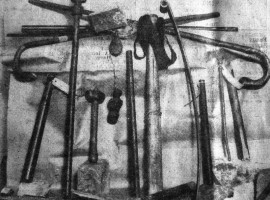
The February 23rd events marked a watershed in relations between the police and the unemployed protestors. It was now far more hazardous for the authorities to violently break up demonstrations; however this did not completely deter the police. At 10.30pm on June 9th 1932, as 6-700 NUWM supporters from east Bristol were making their way home from a rally in Welsh Back, they were ambushed by hundreds of police mounted and on foot in Castle Street. The street lights were conveniently switched off and as police officers waded into the crowds, batons flying, hundreds of film goers emptied out of the Regency Cinema to survey the shocking scenes. One eye-witness stated in The Evening Post ‘…the street looked like a battlefield. Men lay prone in every direction and blood ran on the pavements’. Seventy protestors were injured (twenty-nine seriously), no police officers were injured and there were, conspicuously, no arrests.
Bristol was shocked by the premeditated attack on the marchers; there were stormy meetings in the Council House as the Labour Party demanded a public inquiry, consternation in sections of the press and angry declarations from the labour movement. As a result the police switched their tactics from breaking up marches to arresting the leaders of the NUWM for incitement at public meetings. This ploy eventually put most of the Bristol NUWM leaders behind bars in the later part of 1932 and partly as a result the demonstrations petered out towards the end of the year.
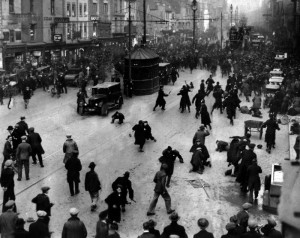
However, the NUWM achieved a number of objectives during their brief rise. After the February ‘riots’, the Council changed their policy of excluding the NUWM deputations, agreed to at least letting them have their say and more importantly postponed the proposed cuts to welfare benefits several times in 1932 saving thousands of families from increased suffering. Eventually, the government also enacted a number of policies to implement the sort of public works that the NUWM had long been asking for. Whether this process necessitated hundreds of injuries and imprisonments is debatable however.
This article is based on research carried out by historians Dave Backwith and Roger Ball. If you would like to read more about the unemployed protests of the 1930s their new pamphlet Bread or Batons?: Unemployed Workers’ Struggles in 1930s Bristol (Bristol Radical History Group 2012) is now available.
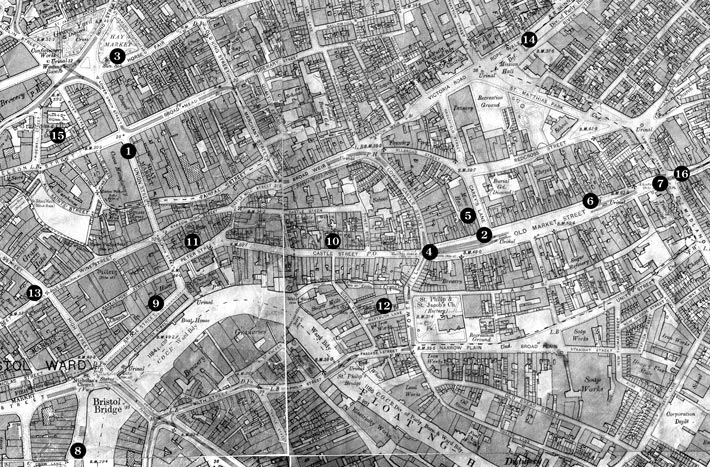
Rob Gardner
In the photo “Police baton charge unemployed workers march on Old Market Street, February 23rd 1932.” The constable in the centre of the picture was my Grandfather, Wallace Beer. Ex Grenadier Guards, and scared the living daylights out of us as children. My grandparents house was as spartan as it gets. When he died every officer on the funeral route stood to attention. My middle name is Wallace.
Karen
I can tell if you are proud or horrified